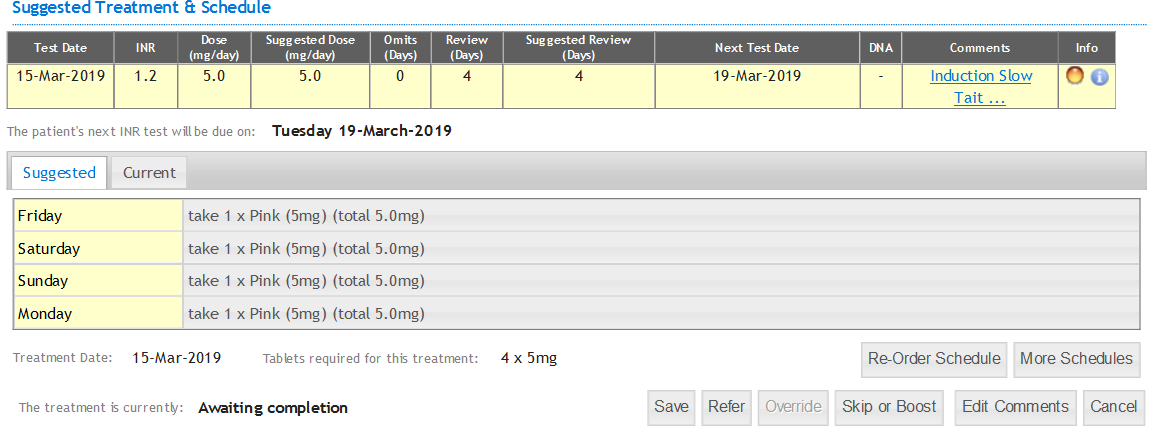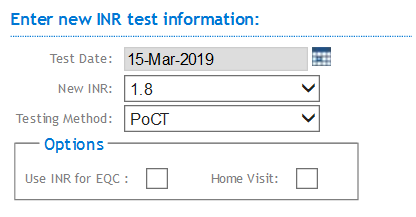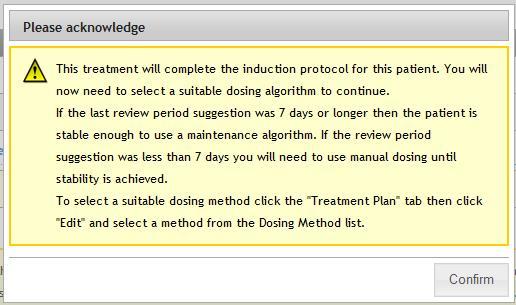Induction Slow Tait
Tait: The Tait algorithm is used for the non-urgent induction of patients requiring an INR of between 2.0 and 3.0.
It cannot be used for:
- urgent induction
- patients who have a baseline INR greater than or equal to 1.4
- patients taking amiodarone.
Reference: Br J Clin Pharmacol. 1998 Aug;46(2):157-61
Warfarin Induction protocols have been designed to initiate Warfarin treatment in patients who are not currently taking Warfarin.
Please click on the attached file to the right to view and print a Tait Slow Induction Flow Chart
This protocol is designed to initiate warfarin treatment in patients for whom a target INR of 2.5 is appropriate and who do not need rapid Induction of anticoagulation (eg. patients with atrial fibrillation ).
It is not suitable for patients who require higher target INRs or in whom rapid anticoagulation is needed (eg prosthetic valves or pulmonary emboli/ DVTs etc).
Before starting this Induction protocol it is essential to ensure that:
- The patient is not currently taking an oral anticoagulant drug.
- The patient is not taking a drug with a potentially significant interaction with warfarin (especially antiplatelet agents , non-steroidal anti-inflammatory drugs and amiodarone).
- They have no evidence of hepatic impairment.
- Their pre-treatment baseline INR is less than 1.4.
- The patient will be able to attend for INR testing on the appropriate days (see below).
The Tait protocol suggests a warfarin dose of 5mg daily with an INR test on the fifth day. Further dosing suggestions will depend on the INR result on this day. A second INR result will be required on the eighth day of treatment.
It is essential that these INR tests are carried out on the correct days otherwise the protocol will be invalidated. In this case the patient will need to be dosed manually until they are sufficiently stable to start on one of INRstar’s Maintenance dosing algorithms.
For patients who are being manually dosed on induction, please see Manual Induction.
Firstly, you will need to add the patient’s demographic details to the system. See ‘Adding a new patient’.
Secondly, you will need to add the relevant clinical details and set the dosing method to an Induction protocol:
Click on  and then on
and then on  on the patient’s record screen to view the Treatment details screen.
on the patient’s record screen to view the Treatment details screen.
Click the  button.
button.

Select a warfarin start date from the calendar icon  . For patients starting an Induction protocol this should be today’s date.
. For patients starting an Induction protocol this should be today’s date.
Select a Diagnosis from the Diagnosis drop-down list.
The recommended target INR and treatment duration will be added automatically.
Users with sufficient permission levels may edit the recommended values if needed.
Set the 'Dosing Method' to Induction by selecting ‘Induction Slow Tait' from the ‘Dosing Method’ drop-down list.

Confirm that this protocol is suitable for your patient when the confirmation dialogue is displayed.
Select the appropriate Testing Method from the ‘Testing method’ drop-down list.
Select the warfarin tablet strengths appropriate for this patient from the 'Tablet Selection'.
Confirm that you have given the patient written information about anticoagulation treatment (eg. ‘Yellow Book’) by clicking the ‘Written Info Provided’ checkbox.
Click the  button to save the clinical details to the patient’s record.
button to save the clinical details to the patient’s record.
Or Click  to exit without saving.
to exit without saving.
The next step is to perform stage 1 of the Induction protocol:
Click on  on the patients clinical record screen.
on the patients clinical record screen.
The Induction protocol stage 1 screen will be displayed.
Click the  button.
button.

A reminder message about the appropriateness of using an Induction message is displayed and beneath it the proposed dosing details and dates of INR tests will be shown.
At this stage it is essential to confirm with the patient that they will be able to attend for repeat INR tests on the days shown. If not, the protocol will be invalidated. If these days are not possible it might be necessary to start the Induction process on a different day so that the necessary review INR tests will occur on convenient days.
Add the pre-treatment INR result by selecting it from the ‘Pre Treatment INR’ drop-down list.
Click the 'Home Visit' checkbox if the test was recorded on a home visit.

Click  to continue.
to continue.
Confirm the pre-treatment INR when the confirmation dialogue is displayed.

The dosing suggestion screen will be displayed. This will indicate the daily dose for the next 4 days and the date of the next INR test.
As this is an Induction protocol it is not possible to override the dose or review period selection at this stage.

Click  to save this treatment suggestion to the patient’s record.
to save this treatment suggestion to the patient’s record.
Or Click  to exit from is screen without saving the details to the record.
to exit from is screen without saving the details to the record.
Please Note: Users with Clinical Level 2 permissions will not be able to save an Induction treatment. It must be referred to a Clinical Level 3 user for authorisation.

When the patient’s INR treatment record screen is displayed, by clicking on the 'Diary' button the patient dosing diary can be printed.
A comment will be added automatically to the INR treatment to indicate that it is an Induction treatment. By clicking on the hyperlink of the first few words of the comment, the full text can be viewed .
Close the patient record by clicking the 'Exit Record' tab.
This occurs when the patient attends for an INR test on Day 5 of the protocol.
Select the patient from the patient search screen (see Search for a patient).
A warning message will be displayed reminding the user that this patient is currently being treated using an Induction protocol. Click 'Confirm' to continue.

Click on  and then
and then  to display the treatment record.
to display the treatment record.
Click  .
.
If the INR test date is not exactly as required by the protocol a warning message will be displayed.

If an INR is added on the wrong day then the protocol is invalidated and INRstar will remove the patient from the Induction process. The patient will then need to be dosed manually until sufficiently stable to be started on an appropriate Maintenance dosing algorithm.
Confirm that the patient is still taking the last warfarin dose which is recorded in the treatment record and that the patient has not missed a warfarin dose since the last clinic attendance, nor started, stopped or changed any other medication since the last appointment.

Select the new INR result from the dropdown list.
![]()
Select a testing method from the dropdown list.
Note: you will only need to do this if the patient’s testing method for this test is different from the default method displayed in the box.![]()
Select a poct batch from the dropdown list.
Note: you will only need to do this if the patient’s testing method is PoCT and your location has more than one PoCT batch activated.
![]()
Click the 'Use INR for EQC' checkbox if you wish to record this test in your External Quality Control (EQC) record log (see ‘adding an EQC result’).
![]()
Click the 'Home Visit' checkbox if the test was recorded on a home visit.
![]()

Click the 'Suggest Warfarin Dose' button.
The new dosing suggestion screen will be displayed with the suggested new dose, review period and dosing schedule.
Please Note: If the new INR is outside the acceptable values specified in the Induction protocol a message will be displayed and the patient will be removed from the Induction protocol. The patient will then need to be dosed manually until sufficiently stable to be started on an appropriate Maintenance dosing algorithm.
Please Note: It is not possible to override a dose or review period suggestion during an Induction protocol.
Click the 'Save' button.
A comment will be added automatically to the treatment to indicate that it is an Induction treatment. By clicking on the hyperlink of the first few words of the comment, the full text can be viewed.
Please Note: Users with permission levels below Clinical Level 3 will note be able to save a INR treatment during an Induction protocol. The INR treatment must be referred for authorisation by a Clinical Level 3 user.
Print the patient dosing diary by clicking the 'Diary' button.
Close the patient record by clicking the 'Exit Record' tab.
Select the patient from the patient search screen (see Search for a patient).
A warning message will be displayed reminding the user that this patient is currently being treated using an Induction protocol.
Click on the ‘INR Treatments’ tab in the 'Treatment Plans' to display the INR treatment record.
Click on the 'New INR' button.
If an INR is added on the wrong day then the protocol is invalidated and INRstar will remove the patient from the Induction process. The patient will then need to be dosed manually until sufficiently stable to be started on an appropriate Maintenance dosing algorithm.
Confirm the patient identity, that the patient is still taking the dose as last recorded, missed warfarin doses and changes to other medication as in stage 2 above.
Select the correct date of the INR test from the calendar icon ![]() . You can choose a date up to 3 days in the past, but the new INR can not be before the previous treatment or on the same date.
. You can choose a date up to 3 days in the past, but the new INR can not be before the previous treatment or on the same date.
![]()
Select the new INR result from the dropdown list.
![]()
Select a testing method from the dropdown list.
Please Note: you will only need to do this if the patient’s testing method for this test is different from the default method displayed in the box.
![]()
Select a poct batch from the dropdown list.
Note: you will only need to do this if the patient’s testing method is PoCT and your location has more than one PoCT batch activated.
![]()
Click the 'Use INR for EQC' checkbox if you wish to record this test in your External Quality Control (EQC) record log (see ‘adding an EQC result’).
![]()
Click the 'Home Visit' checkbox if the test was recorded on a home visit.

Click the 'Suggest Warfarin Dose' button.
This will complete the Induction process and the patient will automatically be removed from the Induction protocol, which will be explained to you in a pop up warning message, shown below. The patient will need to be transferred to a suitable Maintenance algorithm before further dosing suggestions can be calculated. (see Selecting a Maintenance dosing algorithm).

The new dosing suggestion screen will be displayed with the suggested new dose, review period and dosing schedule. The warning explaining about the patient being taken off the induction protocol is also displayed here on the dosing suggestion screen.

Please Note: It is not possible to override a dose or review period suggestion during an Induction protocol.
Click the 'Save' button.
A comment will be added automatically to the treatment to indicate that it is an Induction treatment. By clicking on the hyperlink of the first few words of the comment, the full text can be viewed.
Please Note: Users with permission levels below Clinical Level 3 will note be able to save a treatment during an Induction protocol. The treatment must be referred for authorisation by a Clinical Level 3 user.
Please Note: The patient will be removed from the Induction protocol and their dosing algorithm will now be set to 'No Protocol', a message will be displayed. You will now need to select a suitable dosing algorithm to continue treating them, by editing the patient's clinical details..

Print the patient dosing diary by clicking the 'Diary' button.
Close the patient record by clicking the 'Exit Record' tab.
